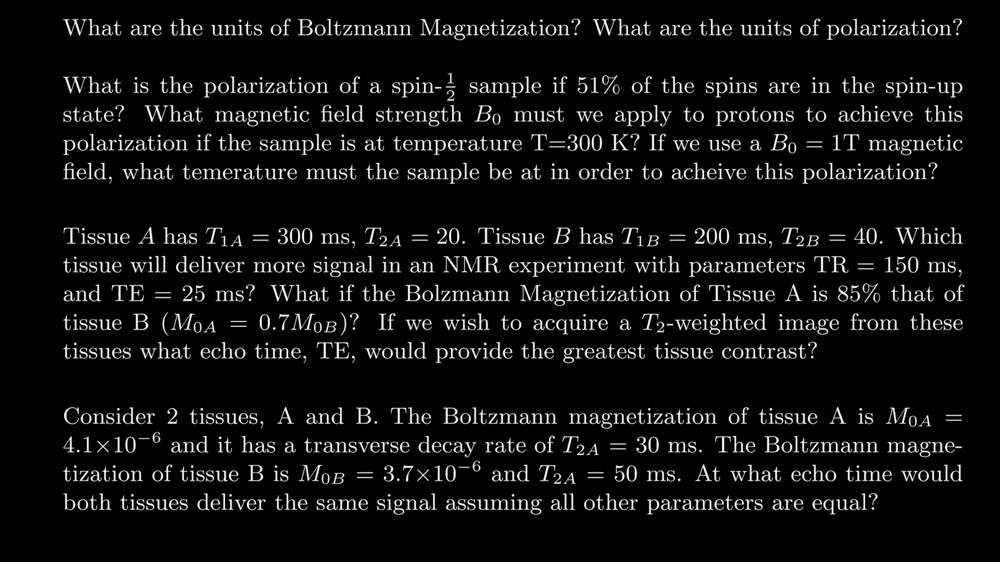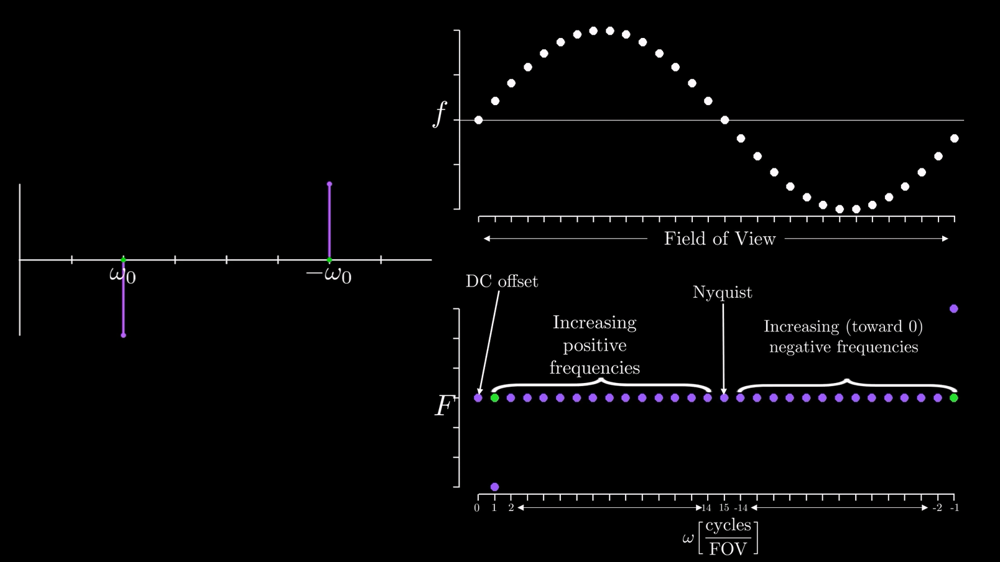The Answers of MRI Tutorial Videos
By Frank Luo
This is my answers of the MRI Tutorial Videos How MRI Works - Part 2: The Spin Echo and How MRI Works - Part 3:Fourier Transform and K-Space .
Part 2: The Spin Echo
Questions


Answers
Question 1:
- The Boltzmann Magetization \(M_0 = \frac{N {\gamma}^2 \hbar^2 B_0}{4 k T}\), then after elimination the units is \(J/T\).
- The Polarization is \(P = \frac{\gamma \hbar B_0}{2kT}\), then after elimination we can get that \(P\) is a special number depends on the material, no SI units.
Question 2:
- The polarization is \(P = \frac{51-49}{100} = 0.02\) .
- The magnet field strength should be \(B_0 = \frac{0.02}{0.0000034} \approx 5882T\) .
- The temperature should be \(T = \frac{300 \times 0.0000034}{0.02} = 0.051K\).
Question 3:
- Since the Boltzmann Magetization Equation is \(M = M_0(1- e^{-\frac{t}{T_1}}) e^{-\frac{t}{T_2}}\) , so we can calculate the signal.
The signal of Tissue \(A\) : \(M_A = M_0(1- e^{-\frac{150}{300}}) e^{-\frac{12.5}{20}} = 0.21\) . The signal of Tissue \(B\) : \(M_B = M_0(1- e^{-\frac{150}{200}}) e^{-\frac{12.5}{40}} = 0.38\) .
Surely Tissue \(B\) will deliver more signal.
- We have calculated that Tissue \(B\) will deliver more signal if both Tissue \(A\) and \(B\) has the same Boltzmann Magetization.
If Tissue \(A\) is \(85\%\) of Tissue \(B\), then the Tissue \(A\) signal will become lesser, so Tissue \(B\) deliver more signal.
- Let function \(f(t) = M_{0A}(1- e^{-\frac{TR}{T_{1A}}})e^{-\frac{t}{T_{2A}}} - M_{0B}(1- e^{-\frac{TR}{T_{1B}}})e^{-\frac{t}{T_{2B}}}\) reprent the signal of time \(t\).
Consider the function: \(f(t) = (1 - e^{-\frac{150}{200}}) e^{-\frac{t}{40}} - (1- e^{-\frac{150}{300}}) e^{-\frac{t}{20}}\) reaches its PEAK at about \(t = 16\), so the \(TE\) should be \(TE = 32ms\).
Question 4:
If both tissues deliver the SAME signal, which means \(M_{0A} e^{-\frac{t}{T_{2A}}} = M_{0B}e^{-\frac{t}{T_{2B}}}\).
Put the data in, then we can get \(4.1e^{-\frac{t}{30}} - 3.7e^{-\frac{t}{50}} = 0\), solve it and get \(t \approx 7.7ms\).
So the echo time is: \(TE = 2 \times t \approx 15.4ms\).
Question 5:
\(e^{-\frac{t}{T_2}}S_0 = e^{-\frac{30}{50}} \approx 0.55\), so the signal is \(0.55mV\).
If the magetic field of inhomogeneity of \(\Delta B = 1\) ppm, the signal can be calculated by such equation:
\[ S(t) = S_0 e^{-\frac{t}{T_2}} e^{- \gamma \Delta B t} \]
Put the data in, we can \(e^{-\frac{30}{50}} e^{-1 \times 267 \times 0.000003} \approx 0.43\), so the signal amplitude is \(0.43\).
- We should delivered the 180° pulses at times 20ms and times 40ms if we wish to detect echoes at times 40ms and 80ms.
The signal will be \(e^{-\frac{40}{50}} \approx 0.45\) at times 40ms and \(e^{-\frac{80}{50}} \approx 0.20\) at times 80ms.
Question 6:
From the equation \(M = M_0 e^{-\frac{t}{T_2}}\), then we can solve \(e^{-\frac{t}{60}} \le 0.1\), the answer is \(t \approx 138.55ms\).
Therefore, we can get the echoes at times 10ms, 30ms, 50ms, 70ms, 90ms, 110ms, 130ms, so we can get \(7\) echoes.
Part 3: Fourier Transform and K-Space
Questions

Answers
The amplitude of the \(\textit{FFT}\) result is \(15\). We need to times \(\frac{2}{N}\) to get the correct answer.
The reason are as follows:
Both the positive and negative frequency contribute the answer, but we only use the positive, so have to multiply \(2\).
Each operation we have to sum once, so we need the result to multiply \(\frac{1}{N}\) to get the final answer.